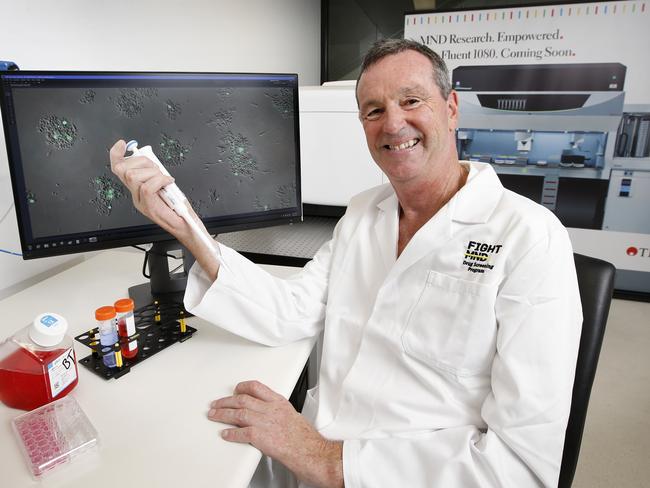FightMND donations fund drug trial slowing progression of disease
A new drug developed by Melbourne researchers has significantly slowed the progression of motor neurone disease in a trial partly paid for by AFL legend Neale Daniher’s Fight MND Foundation. Here’s how it works.
VIC News
Don't miss out on the headlines from VIC News. Followed categories will be added to My News.
EXCLUSIVE: A new drug developed by Melbourne researchers has significantly slowed the progression of motor neurone disease.
It is the first time a treatment has acted on the cause of the disease in humans, rather than on just the symptoms.
The trial of the copper-delivery capsule in 32 patients from Melbourne and Sydney was partly paid for by AFL legend Neale Daniher’s Fight MND Foundation. The trial is the result of 15 years of research and testing at Parkville institutes.
NEALE DANIHER TO STEP BACK TO FOCUS ON OWN MND BATTLE
DANIHER AND GUEST FORGED FRIENDSHIP IN FOOTY AND FREEZE MND
Stunning results after six months’ treatment with the drug, CuATSM, showed that progression of the disease had been slowed by 70 per cent.
Most patients have since continued with the therapy under an extension of the trial.
The drug is also being tested in patients with Parkinson’s disease.
“This is a huge breakthrough,” said Professor Ashley Bush, director of the Melbourne Dementia Research Centre at the Florey Institute of Neuroscience and Mental Health. “This is not a symptomatic treatment. This is an attempt to put out the fire.”
Daniher, diagnosed in 2013 and whose fundraising via events such as the Big Freeze At The ’G has significantly raised the profile of efforts to find a cure, urged Victorians to continue the support.
“We thank everyone who contributes and supports us,” he said. “The fight against MND must continue until a cure is found.”
The phase one safety trial, to which Fight MND contributed $500,000, also improved patients’ lung function, cognition and motor ability.



The research findings were presented at the International Symposium on ALS/MND in Glasgow, Scotland.
A team of five researchers from the Florey, University of Melbourne and Bio21 Institute pursued the theory that a decrease of copper in the brains of those with neurodegenerative diseases was key to its onset.
The group cracked a group of copper compounds that could boost brain cell numbers and improve motor skills of animals with MND and Parkinson’s disease.
The suggestion is the drug works by blocking a type of cell death crucial in these brain diseases.

Next, they sought commercial backing from a US company to turn the compound into a drug suitable for humans.
Most recently they teamed with biopharmaceutical company Collaborative Medicinal Development to run the clinical trial.
Prof Bush, who is also CMD’s chief scientific officer, commenting on the results of the trial, said: “The first chemotherapy in the ’60s was heroic and unprecedented, and they hoped it would become the dominant way of treating the disease.
“But of course, the treatment developed further and there are lots of different approaches to treating cancer,” he said.
“That’s what I think will eventually happen with MND. We haven’t had our big chemotherapy moment in neurodegenerative diseases, but I’m hoping this is it.”

Neale’s daughter and FightMND campaign director Bec Daniher said the findings were encouraging.
“It is extremely heartening to know we are making this slow but steady progress and the funds being committed to research and drug trials are having an impact,” she said.
The next trial later this year, involving about 80 patients in Australia and the US, will pit the treatment against a placebo to confirm its efficacy.
More than 2000 Australians live with MND, which progressively robs them of the capacity to move, speak and breathe as brain cells that control muscles die.
Fight MND’s chief Jamie Howden said this was one of four clinical trials, aiming to protect brain cells in different ways, which the foundation was funding through almost $7 million of public donations.
More research projects will start this year.


